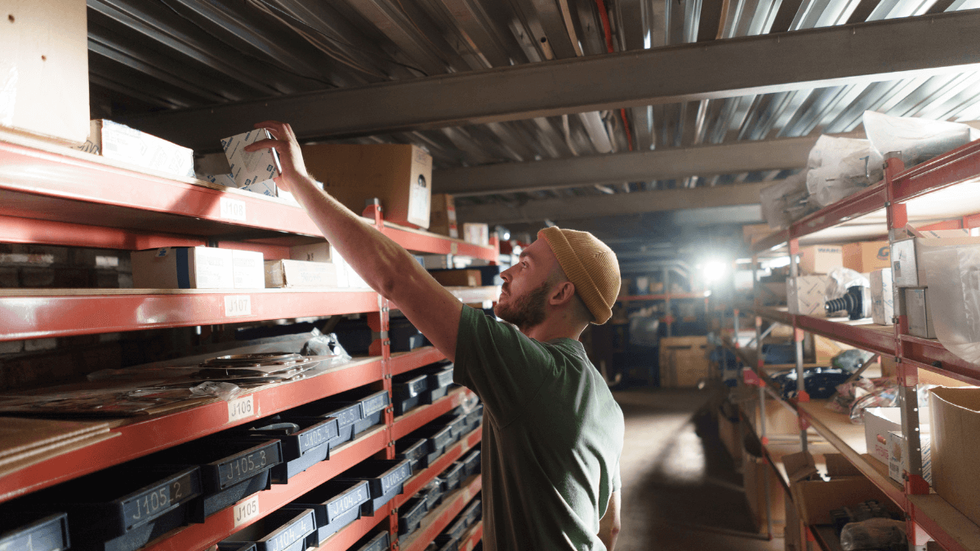A construction project usually begins with a skilled team laying the foundation for the structure made of concrete.
To get this essential job done, the team depends on their tools and equipment, as well as experience and logistic support.
Therefore, in this article, you’ll find an overview of all the essential tools and equipment used by concrete contractors.
In this article...
Screed Machine
You can’t lay a concrete foundation properly without using a screed machine.
Contractors use it to smooth out a concrete surface when it’s still wet. Back in the old days, workers used 2 x 4s to finish a project, so screed machines are quite an improvement.
As you can imagine, there are many kinds of screed machines.
For the sake of this article, we’ll list 3 basic types you should know.
A truss screed is a simple contraption where contractors set up the blade within a truss frame and manually pull it to level the surface. The truss keeps the blade secure, so it is not unevenly pulled on the left or the right side.
For larger surfaces, contractors use roller screed machines. They need to be operated by two contractors (one on each side), with more workers screeding the concrete manually.
You can see how they perform in practice in the video below, starting with the 0:17 mark:
Finally, there are laser screed machines. This kind offers the most precision because they use lasers to identify unleveled surfaces and even them automatically. They’re propelled by an engine that pulls the blade backward.
Wheelbarrows
A wheelbarrow is a staple at any construction site, especially for operations that involve concrete.
It makes transporting the material quicker, and it is incredibly easy to use.
For more intensive operations, contractors use motor-powered wheelbarrows since concrete can be heavy.
If you’re taking a regular wheelbarrow uphill or you’re simply exhausted, it’s easy to lose balance and spill the concrete, so a motorized one is much more convenient.
Besides wet concrete, wheelbarrows are frequently used to carry packed materials and tools.
Portable Mixers
As you know, working with concrete requires that you constantly mix cement with water before being laid down.
If your men are working with a mixer that isn’t portable, they’re going to spend an excessive amount of time going back and forth between the mixer and the worksite, which is not ideal, since concrete needs to be wet when applied.
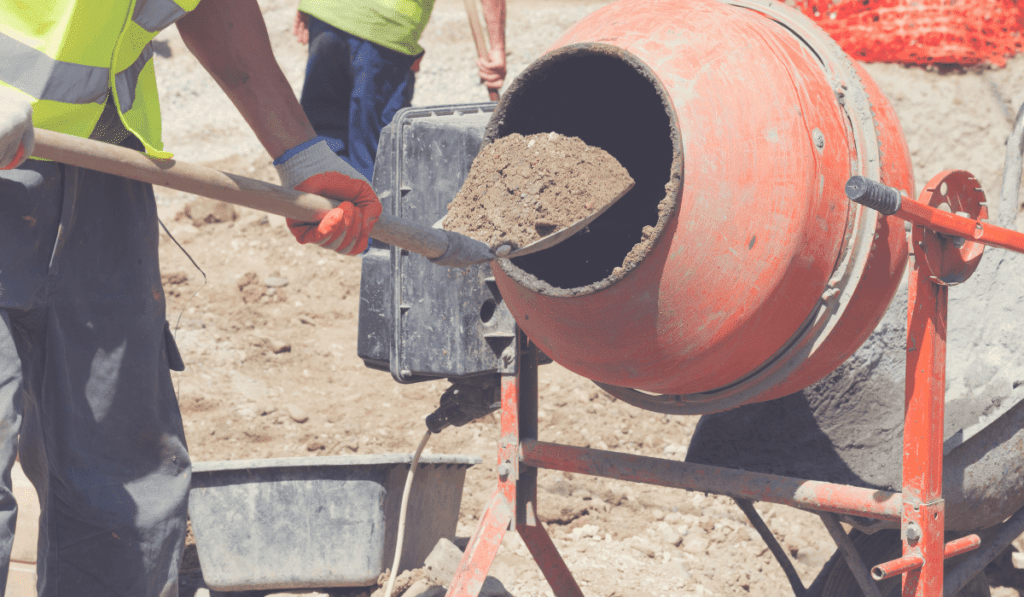
Moreover, the further the mixer stands from the worksite, the greater the likelihood of the material spilling in transport.
On the other hand, portable mixers are easy to move, which means you can mix cement next to the worksite, making spillage virtually impossible, as well as improving your productivity.
Floats
Another integral tool for finishing up a construction project involving concrete is the float.
Contractors use floats to level the surface of the concrete. With every pull backward, a float will cut the heights of the concrete surface and fill in the lows, leaving an even surface of freshly laid concrete behind.

There are several essential things to note.
First, floats come in different sizes. Smaller floats are usually used to reach less accessible points and tight corners on smaller surfaces. They also come without a handle.
However, larger ones are by far the most common, especially across construction sites. They are made from either wood or magnesium.
If you’re working with concrete with air entrainment, use a magnesium float, while for other cases, a wooden float will suffice.
Vapor Barriers
After laying down concrete, it has to dry for the project to be successfully completed. To make sure the concrete slab will dry, contractors use vapor barriers.
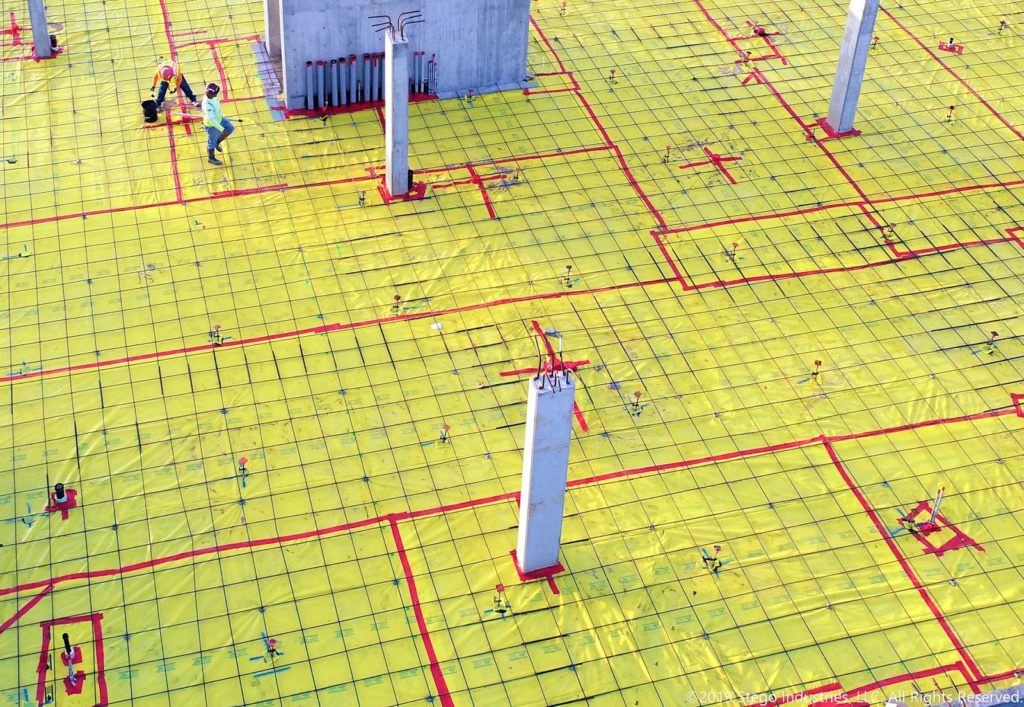
There are different sources of moisture on construction sites. The vapor moves through the concrete and keeps it damp, which leads to a flawed drying process that results in damage.
Some of the most common vapor-related problems are:
- Gaps and pockets in the concrete slab
- Floor damage
- Mold growth
- Weakened concrete strength
A vapor barrier will prevent the moisture from spreading, so that the integrity of the concrete isn’t compromised.
Finally, often, the primary source of moisture is in the ground. That’s why contractors use ground vapor barriers to seal the vapor underneath the concrete slab.
Groove Cutters and Edgers
Often, projects demand that concrete slabs have grooves in them to make further operations easier.
Groove cutters and edges are excellent tools for that job. The powerful motor that moves them allows the blade or disc to cut through damp concrete.
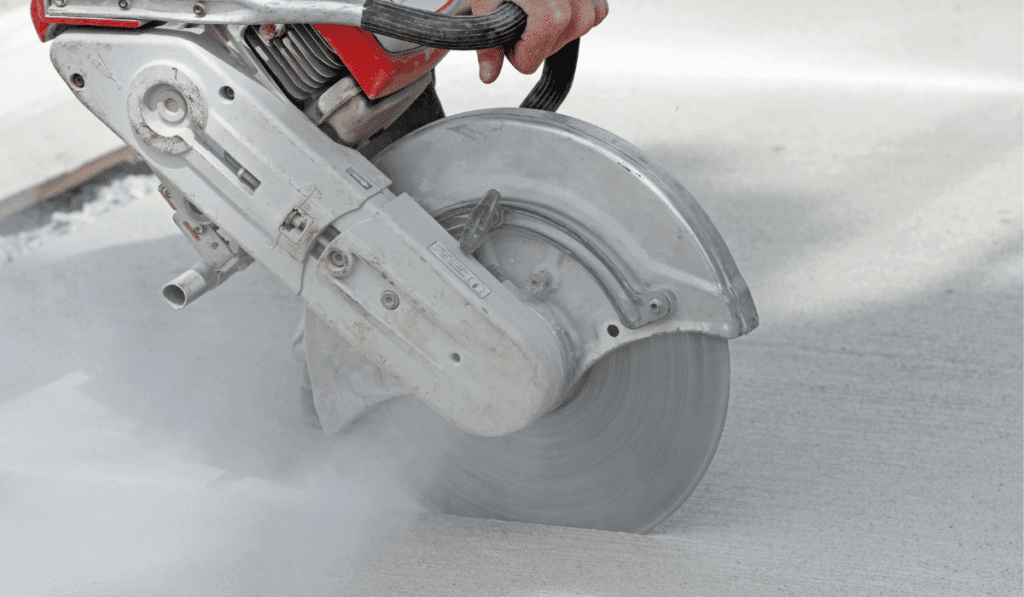
The cutters use a variety of blades, suitable for different kinds of projects. Modern ones also have laser guidance so that contractors can complete the process more accurately.
Also, as is the case with all equipment for concrete, groove cutters and edgers come in different sizes. They’re available as hand tools and as heavier, wheeled equipment for more demanding tasks.
Plate Compactors
Plate compactors are heavily used on projects to compact the ground and eliminate air pockets before laying down concrete.
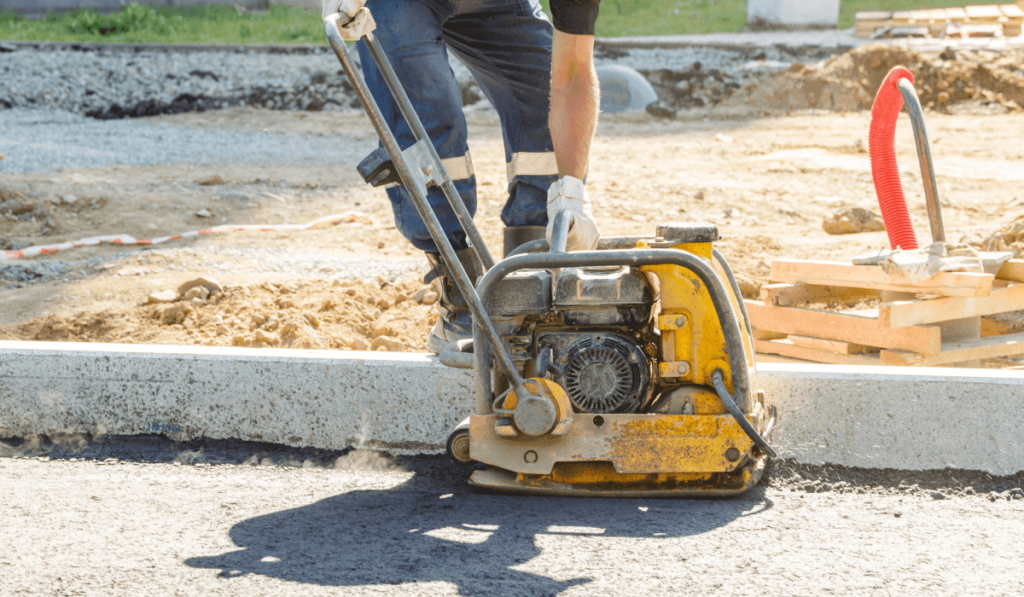
If the ground you’re using as a foundation has air pockets, the integrity of your structure will be compromised. You risk it getting damaged and collapsing under too much weight.
With a plate compactor, contractors can exert force to the ground and ensure it’s ready for concrete.
The basic single plate compactor can exert a force between 3000 to 5000 pounds and is a popular solution for smaller projects.
Heavy-duty compactors have more maneuverability and can release even more force for more demanding contracting operations.
Power Hammers and Drills
Power hammers and drills are often the first things that come to mind when you think of construction yards.
Since concrete is a tough material to go through, contractors use those tools to penetrate it. For example, when contractors are removing old concrete to install a new piping system, you’ll usually see power drills in place.
Similarly, power hammers are usually the first thing you’ll hear in roadside construction. What makes this equipment invaluable is that it can crush concrete but is nevertheless easy to transport and move across the site.
Concrete Batching Plant
Technically speaking, a concrete batching plant is any piece of equipment used to mix materials in order to make concrete.
However, when contractors talk about batching plants, they’re referring to equipment that can mix large amounts of concrete in a short amount of time.
Different construction projects demand different quantities of ready-to-use concrete. Since time is essential in handling concrete, some projects would be impossible to complete only with standard concrete mixers.

A concrete batching plant can mix 50 to 80 cubic yards of concrete in just one hour. When contractors work on a demanding project that involves concrete, they rely on mobile batching plants to mix the concrete and maintain productivity.
This piece of equipment is always larger than portable mixers, but it makes it up with its high mixing capacity.
Concrete Vibrators
As its name implies, a concrete vibrator is a tool that utilizes its hose to cause vibration in wet cement and make it compact and dense. This removes open cavities left in the construction, also known as honeycombs.

Concrete vibrators are frequently used for operations with deeper concrete slabs. For instance, if you’re filling a road hole with concrete, you’d have to use a concrete vibrator to prevent another collapse.
Concrete Pavers
Concrete pavers are indispensable in roadside construction because of their ability to mix concrete and pave the road simultaneously. This is made possible by two crucial features.
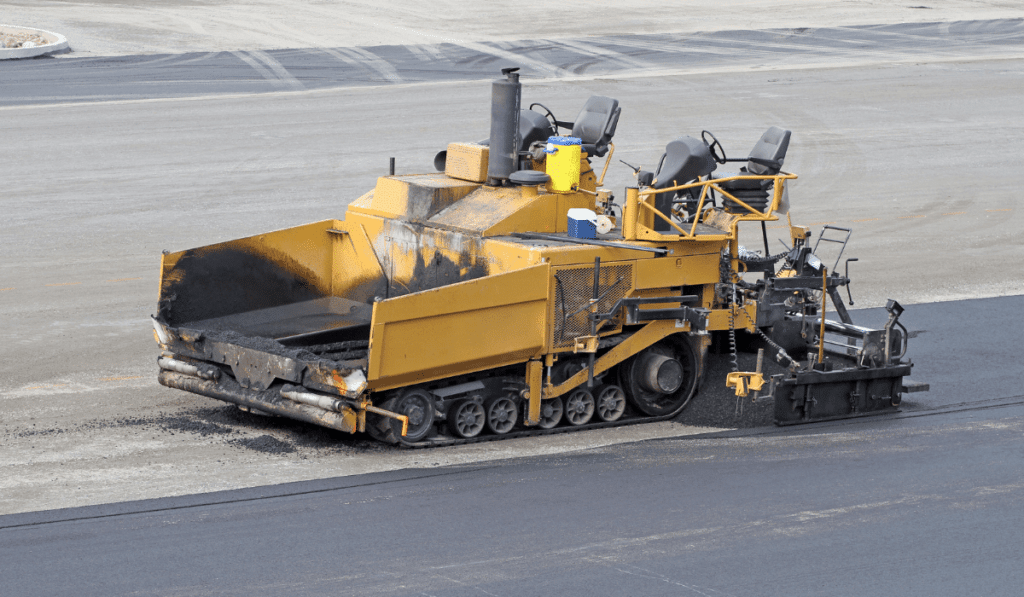
The feeding bucket on top of the machine mixes the wet concrete, and the screed on the bottom dispenses and evens it.
Without concrete pavers, contractors would waste an awful lot of time mixing, laying, and paving the concrete with different pieces of equipment.
Concrete Pumps
A concrete pump is a machine that transports concrete from the truck or tank to where you want to lay down the concrete.
When you’re moving vast amounts of concrete, it would be impossible to move it efficiently without a pump. Concrete pumps are powered by an engine to push wet concrete from the tank through tubes at a force of 25,000 pounds.

The pump’s tube is reinforced with a clamp system so that the pipes don’t break under pressure.
Concrete Tanks
Concrete tanks are a vital piece of equipment for any construction operation that needs vast amounts of concrete.
Such tanks are made to transport and keep wet concrete in a ready-to-use state. The inside of the tank is made of concrete so that the material doesn’t stick. It’s common to see tank trucks and stationary tanks on different construction sites.
Concrete Crushers
As you know, working with concrete also involves breaking down concrete structures. For that task, contractors rely on concrete crushers.
Like other heavy vehicles, concrete crushers are robust machines that rely on their hydraulic arm to pulverize concrete and crush it into bits.
The most distinguishing feature of a concrete crusher is the crusher bucket, used to pick up rubble and move it.

Whenever there’s a heavy-duty demolishing operation, you’re almost guaranteed to see concrete crushers on the job.
Concrete Conveyors
When contractors need to transfer concrete to a less accessible spot, they rely on concrete conveyors.
Without a concrete conveyor, you’d have to engineer a pumping system on-site for a specific project and waste time and resources only to get the material to a higher spot.
Concrete conveyors feature a long conveyor belt that moves the material on a horizontal or vertical line.

The conveyor belt is strong and also made of concrete so that the material you’re moving doesn’t stick to it. Concrete conveyors are easy to deploy and affordable, so contractors regularly rely on them.
Concrete Boom Placers
Boom placers are heavy-duty machines used for dispensing concrete over a construction site fast. They’re often present in sophisticated concrete operations, for instance, when laying down the concrete foundations of a large building.
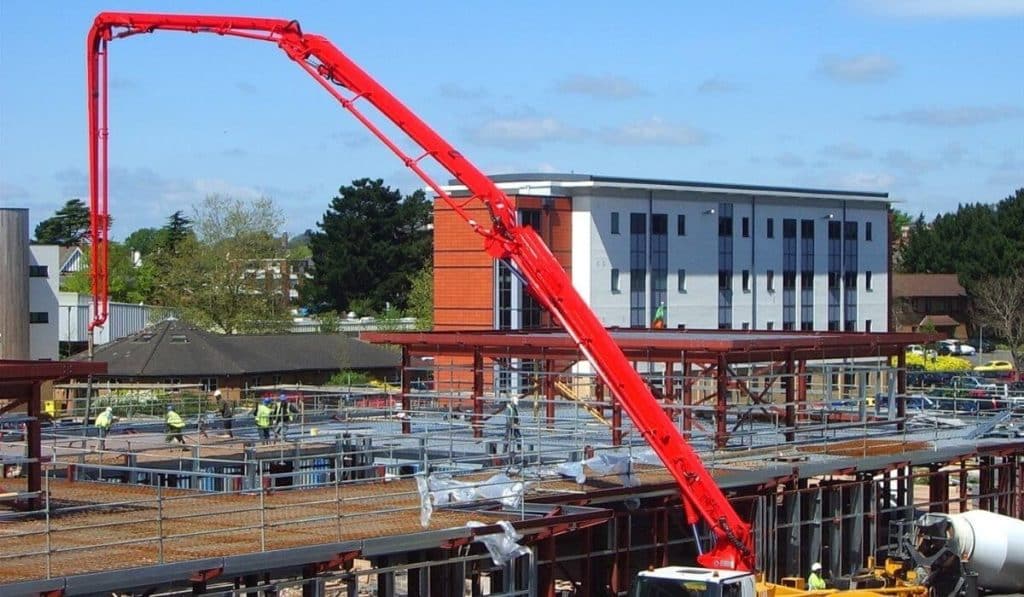
Concrete boom placers rely on a long hydraulic arm to guide the pipe that transfers wet concrete from the tank.
Think of the boom placer as a kind of concrete pump that can reach longer distances; they also rely on high pressure to move large amounts of dozens of yards of concrete in an hour.
Conclusion
At the beginning of this article, we promised to explain all the essential tools and equipment used by concrete contractors—and we’ve delivered.
Laying down concrete might seem straightforward enough, but using specialized tools is not optional to complete the task successfully. Reflect on the list and think about your equipment inventory for concrete-related operations.





